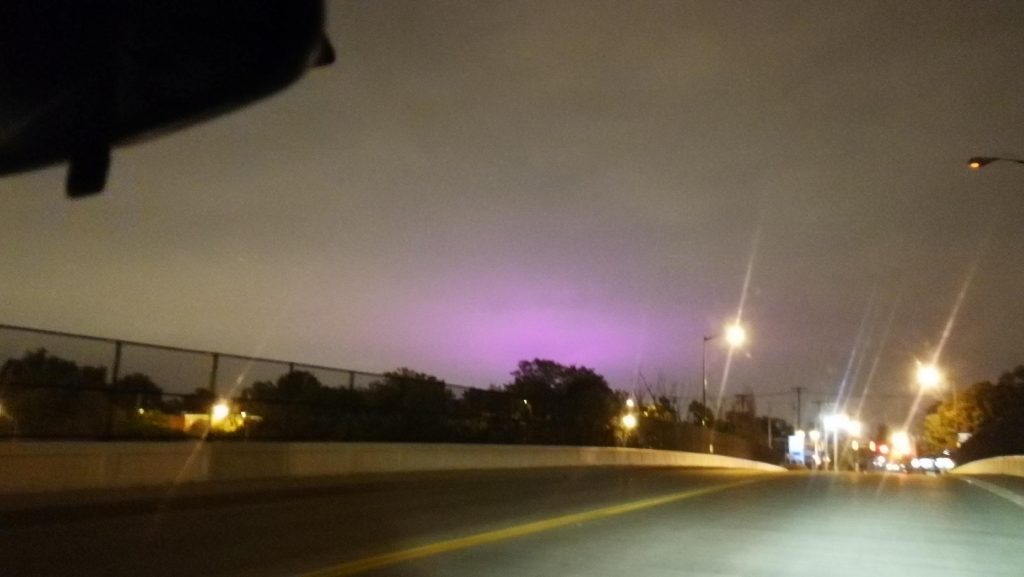Why Cleveland’s Sky Has a Purple Glow (Sometimes)

The picture above was taken a few hours before sunrise in October 2018 in Cleveland, Ohio, and shared on reddit (originally via here). As you can see, it was a cloudy, dark pre-dawn — and there was something purple glowing in the sky. And typically, outside of sunrise or sunset, our skies don’t glow in purple. Was this some weird type of pollution? A UFO? Was Prince returning to Earth from the great beyond?
Nope, none of the above. And nothing so nefarious, either. The culprit: greenhouses.
Greenhouses were invented by the Romans around the year 30 CE to help their emperor, Tiberius, survive a little longer. His health was declining and his doctors suggested he eat a cucumber each day to help stave off whatever malady afflicted him, but there was a problem: cucumbers can’t be grown year-round in Rome. The scientists of the day developed greenhouses as a way to control the climate to make it suitable for growing cucumbers, and over the centuries since, we’ve only gotten better at creating artificial growing conditions.
But while greenhouses can control for climate, they still require land. In areas where there is a lot of farmland, that’s not a big problem. But in places with lots of buildings and a high population density, land is at a premium, and food typically needs to be imported. For a lot of reasons — cost, environmental concerns, and food quality — there are reasons to prefer locally grown crops to those brought in from a far distance away. Agricultural experts have been looking for ways to increase local food production for many, many years.
About fifteen to 20 years ago, the agricultural world began exploring “vertical farming,” or, basically, greenhouses that go up instead of side to side. Climate isn’t a problem — the greenhouses take care of that — and land isn’t a problem when you build up. However, there’s a third problem to solve: light. The sun only shines on the top level of a vertical farm, and the plants at lower levels can’t grow in the dark. As NPR reported, “Light is a major problem with vertical farming. When you stack plants on top of each other, the ones at the top shade the ones at the bottom. The only way to get around it is to add artificial light — which is expensive both financially and environmentally.”
The good news is that there’s a way to mitigate the costs: we can use LED lights instead of the traditional incandescent ones. And if we really want to be efficient, we can use only red and blue LED lights. As Cary Mitchell, a horticulturist at Purdue University told NPR, in the 1990s, “research showed that you could grow lettuce in just red light. If you add a little bit of blue, it grows better.” (If you’re interested in why, a redditor named SuperAngryGuy wrote up a detailed, well-sourced analysis about three years ago, here. I am not sure why he is so angry, though!) These vertical farms, needing artificial light but wanting to minimize the cost, ended up installing a mix of roughly 80% red LEDs and 20% blue ones.
Over the years, traditional horizontal greenhouses have done the same. Typically, those structures were built only to grow crops during daylight hours — sunlight is free, after all! — but when LEDs became cheap and attainable, many installed them and turned on the lights a few hours before sunrise. As the impact of purple lighting spread, many of those greenhouses swapped out their white LEDs for purple ones — including one in Cleveland. A few months before the picture above was taken, a local greenhouse called Green City Growers installed purple LEDs and turned them on at around 4 AM local time. As their general manager told the press, “These LED lights help the plants grow healthier and faster. For example with traditional lighting, it would take about 30-35 days to harvest basil, but with LED lights that time is reduced down to around 28 days.”
And yeah, the pre-dawn risers in the city also get treated to a purple sky — along with their fresher, faster-growing basil.
Bonus fact: In 2022, white streetlights in various parts of the United States and Canada started glowing purple — and no, this wasn’t some plot to grow basil in our city’s streets. It was a weird accident. As the CBC explained, the LEDs that these cities installed weren’t white ones (in fact, no LEDs are inherently white) but rather a purplish-blue color. To get a white effect, the bulbs were covered in a phosphor coating; when the purplish light shone through the coating, it appeared white to anyone walking by. However, due to a manufacturing defect, the coating on many lights faded quickly, and within a few years, the “natural” purple light of the LEDs is what people saw. In Vancouver, Canada, the lights were still under warranty, so the manufacturer picked up the tab to replace the faulty bulbs.
From the Archives: Why the Rainbow Tastes Different Depending on Where You Are: Purple color + food, once again.
